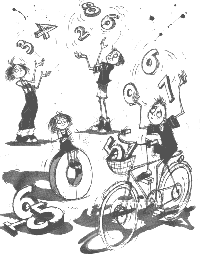 |
It's true:maths can become your
friend
|
 |
Everyone knows maths is dull and dry and,often frightening.Yet once you've got to grips with the basics it can actually be quite fun.
John Rees
Ask some children what their least favourite subject is at
school, and there's a fair chance that most of them will say maths. If you
persist and ask why you'll probably be told that it's
boring. But maths can be a lot of fun, as you and your child will discover
in the exercises below.
All too often, children only see it as dull because they find it difficult;
it's hard to enjoy something that you don't understand or excel at.
So grasping basic maths concepts and skills is essential, not only
for an appreciation of the subject, but because it underpins so many other
areas, especially the sciences. Maths also involves skills that are called
upon in many different ways in daily life - as technology pervades more of
our world from one year to the next, being confidently
numerate has never been so important.
Not surprising, then, that the teaching of maths has undergone
some significant changes over the past 20 or so years. There is less focus
on just coming up with the right answer; and an increasing emphasis
reasoning and proof -
being able to explain what you are doing and why
you are doing it.
That said, your child still needs to develop a good range of basic skills,says
Margeret Brown,professor of maths education at King's College London. "The
numeracy strategy with its daily hour focusing on maths skills, has had a
great impact on the way maths is taught at primary level," she says. "The
focus has largely been on the mental maths skills that primary-age children
need to develop in order to negotiate successfully the more applied maths
at secondary level."
Maths really is a building-block subject and it deserves its place
at the centre of the curriculum. So many other subjects rely on the maths
skills that your children should learn at various stages. Also, it is worth
remembering that, as the curriculum progresses, the maths always relates
back to the maths that was done previously. Therefore, it is essential that
your child's basic maths skills are as strong as possible they will not be
able to progress as far or as fast as you would like.
The Introduction of the National Curriculum, in the late Eighties, changed
the emphasis on maths in primary schools. "When the National Curriculum came
in, it did carry on the earlier emphasis on doing investigation and practical
problem-solving, but that rather got pushed out by the key-stage assessments,
which tended to focus on written and mental arithmetic," explains Professor
Brown. "However, there is some suggestion now of bringing in more work involving
investigation and practical problem-solving at the end of the primary phase,
giving children the skills they will need at secondary level." The new GCSE,
for instance, features both a statistical and an algebraic investigation.
So, what does your child need to know? At Key Stage One, from the
ages of five to seven, children need to
concentrate on getting to grips with the meaning of numbers, developing
counting skills, and learning how to add and subtract. They are also introduced
to simple concepts in the use of numbers and in handling data, such as looking
at how many things they've got, then counting and recording them, which can
in turn lead to drawing up simple bar charts. They also do some basic geometry
work on shapes, playing with those shapes to see what happens for example
when they turn them round or over; and seeing how they fit together.
At Key-Stage Two, from the ages of seven
to 11, the curriculum is divided into four core elements - using and
applying mathematics, numbers, handling data, and shape, space and measures.
Your child will cover the basics of fractions, decimals, proportion and ratio,
as well as starting to use multiplication and division. In handling data,
for instance, they learn how to use averaging measures such as means, medians
and ranges, work that is carried on right through to GCSE.
Although many parents feel that using a calculator is somehow cheating, children
do need to know how to use them properly and efficiently. For example, a
fairly simple maths problem like drawing up a pie chart may involve division
or multiplication sums that are too difficult or long-winded to do by hand.
On occasions like these, it is better to use a calculator to crunch the numbers,
leaving the child free to concentrate on the other aspects of the maths.
At Key Stage Three, from ages 11 to
14 the curriculum expands and diversifies to include the topics
that your child will tackle in more depth at GCSE. Among these are place
value and powers of 10, using coordinates, probability theory,negative numbers,
linear equations,algebra,graphs and piecharts,and geometry.
Across all the different areas there is an increasing emphasis on proof
and reasoning. At GCSE level,failure to show adequately how you got to
an answer results in lost marks.
Who's afraid of all those big bad numbers? |
|
Numbers and sums are much less intimidating and bewildering when you see them at work in the real world.And you don't have to look very far to find them. |
|
| 1 Calculator games Find a calculator with big buttons and a large display, and challenge your children to replicate different numbers they find around the house. Help them find examples on things like your car number plate, your house number; LCD displays, serial numbers, even your age. The aim is for them to reproduce on the calculator display exactly the number they are looking at. This sounds very simple, but it is an excellent way to get younger children used to handling larger numbers, and help them to understand what we mean by place value. |
|
| You will need to explain how the positions on
the calculator reflect how many units, l0s, 1005 and 1,000s the number involves,
and your child will discover that, in order to get the right number on the
display they have to put the largest digit first.You will probably find that
younger children may need to start with simple, single-digit numbers, then
progress up to those of two or three digits.
2 Weighing and measuring activities
3 Learning about shapes
4 Addition and subtraction games |
|
Adventures for budding young number crunchers |
|
One of the best ways to assist your children in understanding arithmetic is to involve them in practical tasks that show how useful maths can be in everyday life. So here are some tricks to have them making a cake out of ratios and fractions, or angling for treasure in the garden |
|
| 1 Which would you prefer? At Key Stage Two, when children have mastered addition and subtraction, they move on to the more complicated functions of multiplication and division. But they don't just need to be able to get the right answer - they need a thorough understanding of what they are actually doing when they multiply or divide a number or set of things. One interesting way of getting this across is to set them some intriguing problems.Try asking what they would prefer: their height in one pound coins or their weight in one pound coins? To solve a conundrum like this they will first need to work out how high they are and how much they weigh, along with the height and weight of a one pound coin thus getting a chance to flex their measuring skills. Bear in mind that coins are rather thin and light to measure accurately so your child may find it easier to stack l0 on top of one another or put l0 on the scales, then divide the answer by 10. |
|
